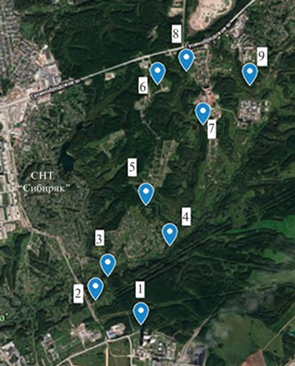Известия РАН. Физика атмосферы и океана, 2022, T. 58, № 6, стр. 648-657
Влияние природно-климатических условий на значения вертикального коэффициента турбулентной диффузии для длительных периодов наблюдения
Н. К. Рыжакова a, Н. С. Рогова a, Е. А. Покровская a, *, К. А. Тайлашева a
a Национальный исследовательский Томский политехнический университет
634050 Томск, пр. Ленина, 30, Россия
* E-mail: pokrelena@tpu.ru
Поступила в редакцию 24.06.2022
После доработки 20.07.2022
Принята к публикации 11.08.2022
- EDN: PMXVQE
- DOI: 10.31857/S0002351522060141
Аннотация
Диффузионно-конвективное уравнение переноса (К-теория) получила широкое распространение в качестве математической основы моделирования дисперсии загрязняющих веществ в атмосферном воздухе. Важным параметром этой модели является вертикальная компонента коэффициента турбулентной диффузии, описывающая перенос мелкодисперсных частиц в вертикальном направлении. Существующие модели вертикальной диффузии разработаны для небольших периодов наблюдения, когда состояние атмосферы можно считать стационарным. Влияние малых концентраций мелкодисперсных частиц на организм человека проявляется при длительном воздействии. В связи с этим основной интерес представляют моделирование дисперсных кривых, усредненных за большие временные промежутки. В работе представлены результаты оценок вертикальных коэффициентов диффузии для периодов наблюдения 2, 8 и 11 месяцев. Результаты получены с помощью полуэмпирического метода, основанного на регрессионном анализе измеренных горизонтальных профилей уровня загрязнения приземного слоя атмосферы выбросами крупных предприятий – угольной теплоэнергетической станции и алюминиевого завода. Для измерения профилей использован метод активного биомониторинга на высоте 1–2 метра. Проведен анализ полученных результатов в зависимости от средней скорости ветра и степени неоднородности поверхности исследованных территорий.
ВВЕДЕНИЕ
В современном мире проблема загрязнения окружающей среды, в том числе атмосферного воздуха, является актуальной и требующей срочного разрешения. Вдыхание загрязненного воздуха и, как следствие, накопление токсинов в организме человека, приводит к ухудшению его здоровья. Переизбыток некоторых элементов имеет непосредственное отношение к заболеванию раком: мышьяк (рак легкого), свинец (рак почек, желудка, кишечника), никель (полость рта, толстого кишечника), кадмий (практически все формы рака) [1–8]. Известно, что выбросы теплоэнергетических предприятий и металлургических заводов в большом количестве содержат тяжелые металлы (ТМ) и другие токсичные элементы. Зоны влияния таких предприятий простираются на большие расстояния, поэтому экспериментальное изучение уровня загрязнения в этом случае традиционными методами требует огромного количества датчиков, то есть является очень трудоемкой задачей. К тому же результаты измерений позволяют определить разовые концентрации загрязняющих веществ. Однако, при решении ряда важных экологических задач, когда концентрации загрязняющих веществ в атмосферном воздухе невелики (как в случае с тяжелыми металлами), а степень опасности определяется, прежде всего, продолжительностью воздействия, период осреднения может составлять годы. Отметим, что в настоящее время проблема длительного воздействия низких концентраций химических веществ в плане возможно скрытых, отдаленных во времени изменений в организме человека становится все актуальнее и чаще привлекает внимание исследователей.
Известным способом изучения основных закономерностей пространственного распределения загрязняющих веществ является математическое моделирование переноса частиц в атмосферном воздухе. Широкое признание получила диффузионно-конвективная модель, которая используется для решения задач масса- и теплопереноса в турбулентной атмосфере [7, 9–12]. Одним из основных параметров этой модели является коэффициент вертикальной диффузии kz.
К настоящему времени имеется большое количество работ, в которых рассматриваются различные способы определения величины kz [12, 13]. Большинство известных способов основано на измерении профилей скорости ветра и температуры по высоте. Однако, вид расчетных формул для величины kz существенным образом зависит от степени устойчивости атмосферы, при которых производятся измерения. В связи с этим полученные по той или иной формуле значения kz могут быть использованы только в расчетах разовых концентраций, когда условия задачи можно считать стационарными. Сравнение расчетных и экспериментальных данных показывает, что условия стационарности выполняются при временах экспозиции датчиков порядка нескольких минут на сравнительно небольших расстояниях от источника, то есть при малых временах переноса. Однако столь малые времена экспозиции не позволяют достоверно измерять концентрацию загрязняющих веществ в атмосферном воздухе, особенно на значительном удалении от источника. Обычно отбор проб воздуха производят в течение 20–30 мин, но даже при таких сравнительно небольших временах экспозиции опытные данные оказываются существенно ниже расчетных. Кроме того, учет эффекта осреднения концентрации за время экспозиции приводит к уменьшению максимальной концентрации примеси в атмосферном воздухе и расстояния, где она достигается. Изменяется зависимость максимальной концентрации от высоты трубы источника, причем расхождение возрастает с увеличением расстояния от источника [12]. Влияние продолжительности экспозиции приближенно можно учесть посредством осреднения коэффициента турбулентной диффузии и скорости ветра. Реально такую процедуру можно осуществить только при сравнительно небольших периодах наблюдения.
Кроме проблем, связанных с приближением стационарности, при определении коэффициента вертикальной диффузии имеются трудности, обусловленные учетом неоднородности поверхности. Хорошо известно, что турбулентность атмосферы существенным образом зависит от рельефа местности и наличия препятствий. Наличие неоднородностей поверхности приводит к возникновению мезомасштабных волн, влияющих на турбулентные потоки [14]. Для учета эффекта неоднородностей поверхности в формулы для kz вводят эмпирический коэффициент шероховатости, значения которого по данным разных авторов имеют значительный разброс даже для простых типов поверхности [12, 13]. Очевидно, реальную местность, особенно урбанизированную, чаще всего нельзя отнести к какому-либо определенному типу.
При решении экологических задач основной интерес представляют усредненные за длительные периоды пространственные распределения выбросов предприятий, которые можно изучать и прогнозировать при известных средних значениях параметров переноса, в том числе вертикальных коэффициентов турбулентной диффузии. В Томском политехническом университете разработан полуэмпирический метод оценки вертикального коэффициента турбулентной диффузии для длительных периодов наблюдения [15]. Метод основан на решении обратной задачи переноса – определении параметров аналитического решения стационарного диффузионно-конвективного уравнения с помощью регрессионного анализа измеренного горизонтального профиля уровня загрязнений в зоне влияния высотного источника. Из-за малости потоков частиц выбросов профиль измерен с помощью метода мхов-биомониторов, который обеспечивает большие времена экспозиции. Сравнение с природным содержанием элементов во мхах позволяет оценить уровень загрязнения атмосферного воздуха без применения нормативов по предельно допустимым концентрациям. Метод широко используется для оценки качества атмосферного воздуха [16–30]. В данной работе использован активный метод мхов-биоиндикаторов, период экспозиции составлял 2, 8 и 11 месяцев. Отобранный на условно чистой территории эпифитный мох Пилезия многоцветковая размещался на исследуемой местности с помощью специальных планшетов, которые крепили к коре деревьев на высоте 1–2 метра [31, 32]
Целью данной работы является оценка значений вертикального коэффициента турбулентной диффузии (kz) для длительных периодов наблюдения и изучение влияния скорости ветра, особенностей рельефа и наличия препятствий на значения kz.
ЭКСПЕРИМЕНТ
Для исследования были выбраны угольная теплоэнергетическая станция в г. Новосибирске (ТЭЦ-5) и Красноярский алюминиевый завод (КРАЗ). Выбор предприятий обусловлен тем, что топливно-энергетические и металлургические комплексы вносят самый большой вклад в загрязнение атмосферы.
Угольная ТЭЦ расположена в центре Евразии, далеко от морей и океанов, поэтому климат здесь континентальный, с холодной продолжительной зимой и коротким жарким летом. Средняя годовая температура воздуха – 0.2°C. Абсолютный максимум – +41.1°C, минимум – –51°C. Годовое количество осадков ≈ 425 мм, из них за период экспозиции 2 месяца (в среднем) 80 мм осадков, за 8 месяцев – 244 мм. Направление ветра в основном западное и юго-западное, реже – северное и северо-восточное. Средняя скорость порыва ветра достигает 5–6 м/с.
Климат города Красноярска незначительно отличается от климата Новосибирска. Средняя годовая температура воздуха – 1.2°C. Абсолютный максимум – +36.4°C, минимум – –52.8°C. Годовое количество осадков ≈465 мм, из них за период экспозиции 2 месяца (в среднем) 121 мм осадков, за период 8 месяцев – 236 мм, в период 11 месяцев – 382 мм. Направление ветра в основном западное и юго-западное, реже – северное и северо-западное. Средняя скорость порыва ветра достигает 5–6 м/с.
Территории, на которых расположены предприятия, отличаются рельефом и наличием препятствий. Зона влияния алюминиевого завода расположена на неоднородной местности, полосы с густой растительностью (преимущественно хвойной) чередуются с полями; зона влияния ТЭЦ-5 – равнина, где находится густой лес, простирающийся на расстояния до 5 км.
В работе использованы данные, полученные разработанным в ТПУ методом активного биомониторинга с помощью эпифитного мха Pylaisia polyantha (Hedw.) [31, 32]. Планшеты с отобранным на условно чистой территории мхом были размещены на различных расстояниях от предприятий в северном (КРАЗ) и северо-восточном (ТЭЦ-5) направлениях, в которых отсутствуют другие источники загрязнения. Схема точек размещения мхов-трансплантантов представлена на рис. 1, 2.
Рис. 2.
Расположение точек размещения мхов-трансплантатов в зоне влияния алюминиевого завода (КрАЗ), г. Красноярск.
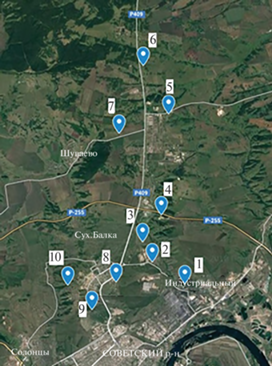
Часть отобранного мха использована для определения фоновых концентраций. Длительность экспозиции в зоне действия ТЭЦ составляла 2 и 8 месяцев, в зоне действия алюминиевого завода 2, 8 и 11 месяцев. При анализе результатов исследования использованы также данные, полученные ранее для ТЭЦ и алюминиевого завода (АЗ), расположенного в г. Кандалакша Мурманской области, методом пассивного биомониторинга; время экспозиции составляло 3 года [15]
Определение содержания химических элементов в образцах мха проведено в научных подразделениях ТПУ: нейтронно-активационным методом на исследовательском ядерном реакторе ИРТ-Т и методом атомно-эмиссионной спектрометрии на спектрометре iCAP6300 Duo научно-аналитического центра.
РЕГРЕССИОННЫЙ АНАЛИЗ РЕЗУЛЬТАТОВ ЭКСПЕРИМЕНТА
Перенос загрязняющих веществ в приземном слое атмосферы описывается стационарным диффузионно-конвективным уравнением [3–7]:
(1)
$u\frac{{\partial q}}{{\partial x}} - {{u}_{z}}\frac{{\partial q}}{{\partial y}} = \frac{\partial }{{\partial z}}{{k}_{z}}\frac{{\partial q}}{{\partial z}},$(2)
$q\left( x \right) = {{\theta }_{1}}{{x}^{{ - {{\theta }_{2}}}}}{\text{exp}}\left( { - \frac{{{{\theta }_{3}}}}{x}} \right) + {{q}_{{\text{ф}}}}.$Характер этой функции определяется значениями параметров ${{\theta }_{2}}$ и ${{\theta }_{3}}$, зависящими от высоты трубы газоочистки, дисперсного состава выбросов, турбулентности атмосферы и других факторов.
В предположении о том, что скорость ветра и вертикальный коэффициент турбулентной диффузии заданы степенными функциями, выражение для параметра ${{\theta }_{3}}$ в случае монодисперсных выбросов имеет вид:
(3)
${{\theta }_{3}} = \frac{{{{u}_{1}}{{{\left( {\frac{H}{{{{z}_{1}}}}} \right)}}^{n}}H}}{{{{{\left( {1 + n} \right)}}^{2}}{{k}_{{{\text{пр}}}}}}}.$(4)
${{\bar {k}}_{z}} = {{k}_{{{\text{пр}}}}}z = \frac{{\bar {u}\left( {{{z}_{1}}} \right){{{\left( {\frac{H}{{{{z}_{1}}}}} \right)}}^{n}}H}}{{{{{\left( {1 + n} \right)}}^{2}}{{\theta }_{3}}}}z,$Содержание химических элементов во мхах пропорционально их концентрациям в атмосферном воздухе, поэтому при обработке результатов эксперимента в качестве уравнения регрессии использована зависимость (2). Отметим, что сравнение с природным содержанием элементов во мхах (qф) позволяет оценить уровень загрязнения атмосферного воздуха без применения нормативов по предельно допустимым концентрациям.
Для регрессионного анализа использованы концентрации тех элементов, у которых наблюдалась функциональная зависимость (2), характеризующаяся наличием ярко выраженного максимума. В качестве примера на рисунках изображены распределения концентраций Yb и Sb в зоне влияния ТЭЦ-5 (рис. 3) и Ti и Be в зоне влияния КРАЗ (рис. 4).
Рис. 3.
Пространственное распределение химических элементов во мхах в зависимости от расстояния от Новосибирской ТЭЦ-5 (⚫ – 2 месяца; X – 8 месяцев; --- – фоновые концентрации).
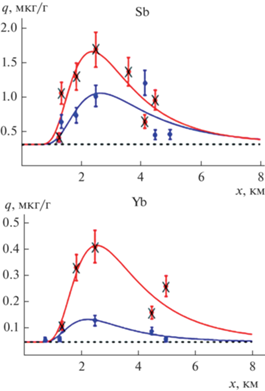
Рис. 4.
Пространственное распределение химических элементов во мхах в зависимости от расстояния от Красноярского алюминиевого завода (⚫ – 8 месяцев; X – 11 месяцев; --- – фоновые концентрации).
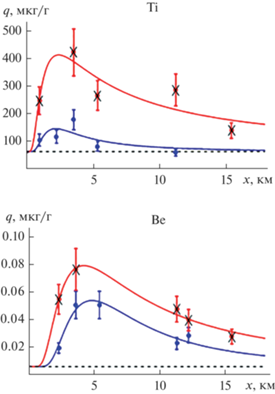
В результате регрессионного анализа концентраций химических элементов в образцах мха были получены значения параметров ${{\theta }_{3}}$, которые использованы для оценки усредненного по периоду наблюдения ${{\bar {k}}_{{zi}}}$ для разных химических элементов. Расчеты проведены при n = 0.2. Средняя скорость ветра на высоте z1 = 10 м была рассчитана на основе данных сайта Gismeteo [34, 35].
В табл. 1 и 2 приведены основные статистические показатели для выборок значений $~{{\bar {k}}_{{zi}}}$ для разных химических элементов на высоте 1 м в зоне влияния ТЭЦ-5 (табл. 1) и КРАЗ (табл. 2). В таблицах использованы следующие обозначения:
Таблица 1.
Основные статистические показатели для выборок значений $~{{\bar {k}}_{{zi}}}$ для разных химических элементов на высоте 1 м в зоне влияния ТЭЦ (H = 260 м)
| Период экспозиции | Средняя скорость ветра $\bar {u}$ на высоте 10 м | Количество элементов в выборке, n | Диапазон значений $\overline {{{k}_{{zi}}}} $ на высоте 1 м для разных хим. элементов, м2/с | $\left\langle {{{{\overline {~k} }}_{z}}} \right\rangle $ на высоте 1 метр, м2/с | σ, м2/с | V, % |
|---|---|---|---|---|---|---|
| 2 месяца | 1.6 | 9 | 0.018–0.063 | 0.043 | 0.015 | 34% |
| 8 месяцев | 1.5 | 11 | 0.019–0.067 | 0.038 | 0.013 | 35% |
Таблица 2.
Основные статистические показатели для выборок значений $~{{\bar {k}}_{{zi}}}$ для разных химических элементов на высоте 1 м в зоне влияния КРАЗ (H = 120 м)
| Период экспозиции | Средняя скорость ветра $\bar {u}$ на высоте 10 м | Количество элементов в выборке, n | Диапазон значений $\overline {{{k}_{{zi}}}} $ для разных хим. элементов на высоте 1 м, м2/с | $\left\langle {{{{\overline {~k} }}_{z}}} \right\rangle $ на высоте 1 м, м2/с | σ, м2/с | V, % |
|---|---|---|---|---|---|---|
| 2 месяца | 1.6 | 6 | 0.010–0.118 | 0.059 | 0.036 | 61% |
| 8 месяцев | 1.9 | 12 | 0.017–0.218 | 0.075 | 0.051 | 68% |
| 11 месяцев | 2.2 | 11 | 0.039–0. 153 | 0.093 | 0.040 | 42% |
На рис. 5 приведены усредненные по химическим элементам значения $\left\langle {~{{{\bar {k}}}_{z}}} \right\rangle $, а также результат, полученный в зоне действия ТЭЦ-5 с помощью пассивного биомониторинга для периода экспозиции 3 года при средней скорости ветра 3.7 м с–1 [15].
Рис. 5.
Средние значения вертикального коэффициента турбулентной диффузии $\left\langle {{{{\bar {k}}}_{z}}} \right\rangle $ для разной средней скорости ветра.
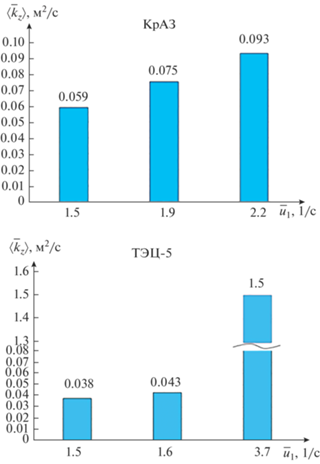
Видно, что в зоне действия ТЭЦ-5 при увеличении средней скорости ветра примерно на 7% $\left\langle {{{{\bar {k}}}_{z}}} \right\rangle $ увеличивается почти на 10%. В зоне влияния КРАЗ $\left\langle {{{{\bar {k}}}_{z}}} \right\rangle ~$ возрастает примерно на 20% для каждого последующего периода экспозиции. При этом средняя скорость ветра соответственно увеличивается на 27 и 16%. Выявленная тенденция характеризуется ростом $\left\langle {{{{\bar {k}}}_{z}}} \right\rangle $ с увеличением $\bar {u}\left( {{{z}_{1}}} \right)$ и имеет нелинейный характер. Напомним, что в большинстве математических моделей коэффициента турбулентности предполагается линейная зависимость от скорости ветра [12, 13]. Из данных таблицы 1, 2, а также данных , полученных для ТЭЦ в работе [15] с помощью пассивного мониторинга и периода экспозиции 3 года $\left\langle {{{{\bar {k}}}_{z}}} \right\rangle ~\,\, = 1.5~\,\,{{{\text{м}}}^{{\text{2}}}}{\text{/с}}$ при $\bar {u} = 3.7\,\,~{\text{м/с}}$, следует, что усредненные за длительные периоды коэффициенты $\left\langle {{{{\bar {k}}}_{z}}} \right\rangle $ растут существенно быстрее. Быстрый рост турбулентности с увеличением скорости ветра обусловлен сильным влиянием неоднородности поверхности. В известных математических моделях турбулентности степень неоднородности поверхности описывается с помощью эмпирического параметра шероховатости, оценки которого получены для простых типов поверхности. Однако, значение параметра шероховатости зависит не только от наличия препятствий, но и от устойчивости атмосферы [12, 13]. Для иллюстрации вышесказанного сравним значения коэффициента $\left\langle {{{{\bar {k}}}_{z}}} \right\rangle $ для территорий, характеризующихся разной степенью неоднородности подстилающей поверхности. Так в зоне влияния КРАЗ полосы с густой растительностью чередуются с полями; зона влияния ТЭЦ расположена на равнине, где находится густой лес, простирающийся на расстоянии до 5 км, т.е. поверхность более однородна. Разумеется, сравнение будем проводить для значений $\left\langle {{{{\bar {k}}}_{z}}} \right\rangle $, определенных при одинаковой средней скорости ветра. Из сравнения результатов (рис. 5), полученных при $\bar {u}\left( {{{z}_{1}}} \right)$ = 1.5 м/с видно, что коэффициент турбулентной диффузии в зоне влияния КРАЗ примерно на 40% выше, чем в зоне влияния ТЭЦ. Сильным влиянием неоднородности поверхности на турбулентность приземного слоя объясняется большая разница коэффициентов диффузии при почти одинаковой средней скорости ветра в зонах влияния КРАЗ (г. Красноярск) и алюминиевого завода (АЗ), расположенного г. Кандалакша [15]: в зоне действия КРАЗ ($\bar {u} = 2.2~\,\,{\text{м/с}}$) $\left\langle {{{{\bar {k}}}_{z}}} \right\rangle ~\,\, = 0.93~\,\,{{{\text{м}}}^{{\text{2}}}}{\text{/с}}$; в зоне действия АЗ ($\bar {u} = 2.3~\,\,{\text{м/с}}$) $\left\langle {{{{\bar {k}}}_{z}}} \right\rangle ~\,\, = 0.02~\,\,{{{\text{м}}}^{{\text{2}}}}{\text{/с}}$. В отличие от зоны влияния КРАЗ, где полосы с лесной растительностью чередуются с полями, в зоне влияния АЗ располагается сплошной лесной массив, что препятствует развитию интенсивной турбулентности.
ЗАКЛЮЧЕНИЕ
Определение вертикального коэффициента турбулентной диффузии основано на измерении быстро меняющихся величин, характеризующих состояние атмосферы. Очевидно, что коэффициенты kz, определенные разработанными к настоящему времени способами, не могут быть использованы в наиболее интересных случаях, когда изучается осредненное за продолжительные промежутки времени пространственное распределение загрязняющих веществ на территориях с существенно неоднородной поверхностью. В связи с этим возникает задача определения эффективных значений $\left\langle {{{{\bar {k}}}_{z}}} \right\rangle $, которые устанавливаются в соответствии с данными опыта для больших периодов наблюдения. Такой подход часто используется при описании сложных физических явлений, когда строгая математическая формулировка задачи невозможна или не имеет практического значения. Например, в работе [10] показано, что эффект осреднения даже за небольшие времена экспозиции (20–30 мин) условно описывается введением эффективного коэффициента диффузии, учитывающего пульсации направления ветра за время осреднения. При решении экологических задач для крупных промышленных предприятий с большими зонами влияния основной интерес представляют пространственные распределения загрязняющих веществ, усредненные за продолжительные временные промежутки. Возможность изучения средних уровней загрязнения предоставляет метод мхов-биомониторов. Методом активного биомониторинга с помощью эпифитного мха измерены горизонтальные профили уровней загрязнения в зонах влияния двух крупных предприятий – угольной теплоэнергетической станции и алюминиевого завода на расстояниях до 5–6 км и разных по продолжительности периодов экспозиции. Измеренные профили использованы для оценки эффективных значений коэффициентов вертикальной диффузии. Анализ показывает более быстрый рост коэффициентов с увеличением скорости ветра, чем это предсказывают полуэмпирические модели для небольших периодов наблюдения порядка нескольких минут. Скорее всего, этот результат объясняется существованием кратковременных порывов ветра, которые не учитываются в моделях. Необходимо отметить, что выявленные тенденции изменения эффективных значений вертикального коэффициента турбулентной диффузии не противоречат устоявшимся представлениям о влиянии скорости ветра и неоднородности поверхности на интенсивность турбулентных потоков. Использованный в работе метод оценки эффективных коэффициентов турбулентной диффузии в вертикальном направлении для длительных периодов наблюдения можно использовать для изучения зависимости коэффициентов от скорости ветра в зонах действия крупных предприятий. Выявленные тренды могут быть использованы для моделирования дисперсии загрязняющих веществ в приземном слое атмосферы и определении размеров зон влияния предприятий.
Список литературы
Hofmann W. Modelling inhaled particle deposition in the human lung–A review // Journal of Aerosol Science. 2011. T. 42. № 10. C. 693–724.
Luo P. et al. Size-dependent atmospheric deposition and inhalation exposure of particle-bound organophosphate flame retardants // Journal of hazardous materials. 2016. V. 301. P. 504–511.
Sturm R. Modeling the deposition of bioaerosols with variable size and shape in the human respiratory tract–A review // Journal of Advanced Research. 2012. T. 3. № 4. C. 295–304.
Tchounwou P.B., Yedjou C.G., Patlolla A.K., Sutton D.J. Heavy Metal Toxicity and the Environment // In Molecular, Clinical and Environmental Toxicology. 2012. P. 133–164.
World Health Organization. Review of Evidence on Health Aspects of Air Pollution–REVIHAAP Project Technical Report // World Health Organization. 2013. P. 309.
Мудрый И.В., Короленко Т.К. Тяжелые металлы в окружающей среде и их влияние на организм // Издание: врачебное дело. 2002. С. 32-37.
Mandel A. et al. Setting threshold values of particle sizes for determination of the appropriate dispersion/deposition model during various atmospheric stability conditions //Atmospheric Environment. 2015. T. 105. C. 181–190.
Viana M. et al. Partitioning of trace elements and metals between quasi-ultrafine, accumulation and coarse aerosols in indoor and outdoor air in schools // Atmospheric Environment. 2015. T. 106. C. 392–401.
Chamecki M. An analytical model for dispersion of biological particles emitted from area sources: Inclusion of dispersion in the crosswind direction // Agricultural and forest meteorology. 2012. T. 157. C. 30–38.
Zhang Y., Hu R., Zheng X. Large-scale coherent structures of suspended dust concentration in the neutral atmospheric surface layer: A large-eddy simulation study // Physics of Fluids. 2018. T. 30. № 4. C. 046 601.
Moreira D.M. et al. A contribution to solve the atmospheric diffusion equation with eddy diffusivity depending on source distance // Atmospheric Environment. 2014. T. 83. C. 254–259.
Берлянд М.Е. Прогноз и регулирование загрязнения атмосферы. Л.: Гидрометеоиздат, 1985. 272 с.
Лайхтман Д.Л. Физика пограничного слоя атмосферы. Л.: Гидрометеоиздат, 1970. 342 с.
Панин Г.Н., Бернхофер Х. Параметризация турбулентных потоков над неоднородными ландшафтами // Известия РАН. Физика атмосферы и океана. 2008. Т. 44. № 6. С. 755–772.
Ryzhakova N.K., Borisenko A.L., Babicheva V.O. Use of moss biomonitors for turbulent transport coefficient estimation for industrial emissions. Atmospheric Pollution Research, 2017, V. 8(5), p. 997–1004.
Długosz-Lisiecka M., Wróbel J. (2014) Use of moss and lichen species to identify 210 Po-contaminated regions. Environmental Science: Processes & Impacts 16(12): 2729–2733.
Motyka O. et al. Moss biomonitoring and air pollution modelling on a regional scale: delayed reflection of industrial pollution in moss in a heavily polluted region? // Environmental Science and Pollution Research. 2020. T. 27. № 26. C. 569–578.
Urošević M.A. et al. Urban background of air pollution: Evaluation through moss bag biomonitoring of trace elements in Botanical garden // Urban Forestry & Urban Greening. 2017. T. 25. C. 10–19.
Gecheva G. Atmospheric Pollution Assessment with Mosses in Bulgaria // Journal of BioScience and Biotechnology. 2016. T. 5. № 2. C. 125–128.
Zhou X. et al. Using moss to assess airborne heavy metal pollution in Taizhou, China // International journal of environmental research and public health. 2017. T. 14. № 4. C. 430.
Bajraktari N., Morina I., Demaku S. Assessing the presence of heavy metals in the area of glloogoc (Kosovo) by using Mosses as a bioindicator for heavy metals // Journal of Ecological Engineering. 2019. T. 20. № 6.
Godzik B. Use of Bioindication Methods in National, Regional and Local Monitoring in Poland—Changes in the Air Pollution Level over Several Decades // Atmosphere. 2020. T. 11. № 2. C. 143.
Barandovski L. et al. Atmospheric heavy metal deposition in north macedonia from 2002 to 2010 studied by moss biomonitoring technique // Atmosphere. 2020. T. 11. № 9. C. 929.
Kapusta P., Godzik B. Temporal and Cross-Regional Variability in the Level of Air Pollution in Poland—A Study Using Moss as a Bioindicator // Atmosphere. 2020. T. 11. № 2. C. 157.
Derrien M.M. et al. Toward environmental justice in civic science: Youth performance and experience measuring air pollution using moss as a bio-indicator in industrial-adjacent neighborhoods // International Journal of Environmental Research and Public Health. 2020. T. 17. № 19. C. 72–78.
Svozilíková Krakovská A. et al. Analysis of Spatial Data from Moss Biomonitoring in Czech–Polish Border // Atmosphere. 2020. T. 11. № 11. C. 1237.
Stafilov T. et al. Atmospheric Mercury Deposition in Macedonia from 2002 to 2015 Determined Using the Moss Biomonitoring Technique // Atmosphere. 2020. T. 11. № 12. C. 1379.
Betsou C. et al. First-Time Source Apportionment Analysis of Deposited Particulate Matter from a Moss Biomonitoring Study in Northern Greece // Atmosphere. 2021. T. 12. № 2. C. 208.
Świsłowski P., Ziembik Z., Rajfur M. Air Quality during New Year’s Eve: A Biomonitoring Study with Moss // Atmosphere. 2021. T. 12. № 8. C. 975.
Paçarizi M. et al. Estimation of Elements’ Concentration in Air in Kosovo through Mosses as Biomonitors // Atmosphere. 2021. T. 12. № 4. C. 415.
Rogova N., Ryzhakova N., Gusvitskii K., Eruntsov V. Studying the influence of seasonal conditions and period of exposure on trace element concentrations in the moss-transplant Pylaisia polyantha // Environmental Monitoring and Assessment . 2021. V. 193, I. 4. P. 168–177.
Borisenko A.L., Ryzhakova N.K., Rogova N.S. Mosses as indicators of urban environmental pollution: Examples of pylaisia polyantha (HEDW.) BSG from West Siberia // Mosses: Ecology, Life Cycle and Significance. 2018. P. 27–57.
Рыжакова Н.К., Покровская Е.А., Бабичева В.О. Оценка вертикального коэффициента турбулентной диффузии выбросов промышленных предприятий// Известия РАН. Физика атмосферы и океана. 2015 . Т. 51. № 4.
https://www.gismeteo.ru/diary/4690/2010/10/.
https://www.gismeteo.ru/diary/4674/2010/10.
Дополнительные материалы отсутствуют.
Инструменты
Известия РАН. Физика атмосферы и океана


